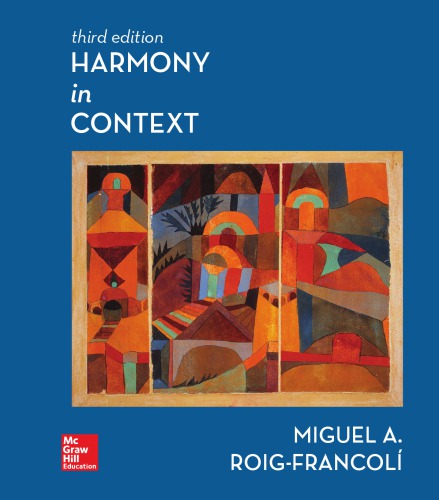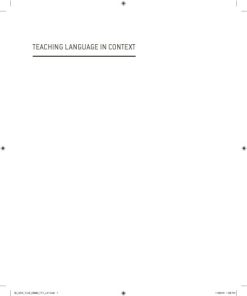Harmony in Context Miguel 3rd edition by Miguel Roig Francoli ISBN 1260153851 9781260153859
$50.00 Original price was: $50.00.$25.00Current price is: $25.00.
Harmony in Context Miguel 3rd edition by Miguel Roig-Francoli – Ebook PDF Instant Download/Delivery: 1260153851 , 978-1260153859
Full download Harmony in Context Miguel 3rd Edition after payment

Product details:
ISBN 10: 1260153851
ISBN 13: 978-1260153859
Author: Miguel Roig-Francoli
Harmony in Context Miguel 3rd Table of contents:
Part 1: Diatonic Harmony
Chapter 1: Harmonic Progression. The Connection of Chords
- Harmonic Progression
- Notating, Voicing, and Spacing Chords
- Chord Connection: The Principles of Part Writing
- Voice-Leading Guidelines for the Three Basic Types of Progression
- Melodic Style
- The Big Picture: Voice Independence
Chapter 2: The Fundamental Progression: The Tonic and Dominant Triads in Root Position
- The Tonic Triad
- The Dominant Triad
- The I–V–I Progression
- Characteristic Soprano-Bass Patterns
- The Big Picture: The I–V–I Progression as a Form-Generating Structure
- Procedure: Identifying Cadences and Phrases
- Pitch Patterns
Chapter 3: Harmonic Function; The Subdominant Triad in Root Position
- The Basic Harmonic Functions
- The Subdominant Triad
- Characteristic Soprano-Bass Patterns
- The Big Picture: A Model to Elaborate the Fundamental Progression
- Pitch Patterns
Chapter 4: Triads in First Inversion
- The Triad in First Inversion: Uses and Function
- The Neighbor V6
- Characteristic Soprano-Bass Patterns
- The Big Picture: Elaborating the I–V–I Progression
- Pitch Patterns
Chapter 5: The Supertonic; Melody Harmonization
- The Supertonic in Root Position
- The Supertonic in First Inversion
- Characteristic Soprano-Bass Patterns
- The Big Picture: Elaborating the I–V–I Progression
- Procedure: Harmonizing a Melody
- Pitch Patterns
Chapter 6: Nonchord Tones
- The Passing Tone
- The Neighbor Note
- The Anticipation
- Incomplete Neighbors
- Suspensions
- Pedal Point
Chapter 7: 64 Chords
- Consonant 64 Chords: The Arpeggiated 64
- Dissonant 64 Chords
- The Neighbor 64
- The Passing 64
- The Cadential 64
- Characteristic Soprano-Bass Patterns
- The Big Picture: Elaborating The I–V–I Progression
- Pitch Patterns
Chapter 8: The Dominant Seventh and Its Inversions
- V7 in Root Position
- Inversions of the Dominant Seventh
- Characteristic Soprano-Bass Patterns
- The Big Picture: Elaborating the I–V–I Progression
- Pitch Patterns
Chapter 9: The Leading-Tone Triad
- Doubling and Voice Leading
- The Passing vii°6
- vii°6 as a Dominant Substitute
- The Leading-Tone Cadence
- Characteristic Soprano-Bass Patterns
- The Big Picture: Elaborating the I–V–I Progression
- Pitch Patterns
Chapter 10: Cadences
- Authentic Cadences
- The Half Cadence
- The Plagal Cadence
- The Deceptive Cadence
- Pitch Patterns
Chapter 11: Building the Context for Harmony I: Phrase Structure
- Motive
- Phrase
- Period Structure
- The Big Picture: Form Diagrams
- More on Period Structure
- Phrase Group
Chapter 12: Building the Context for Harmony II: Thematic Development; Phrase Extension
- Melodic Developmental Techniques
- Phrase Extension
Chapter 13: Harmonic Rhythm; Metric Reduction
- Harmonic Rhythm
- The Big Picture: Metric Reduction: A Tool for Practice and Performance
- Compound Melody
- Procedure: Composing Your Own Progressions
Chapter 14: The Mediant, Submediant, and Subtonic Triads
- The Mediant and Submediant Triads as Prolongations of the Tonic
- Other Uses of the Mediant and Submediant
- The Subtonic
- Characteristic Soprano-Bass Patterns
- The Big Picture: Elaborating the I–V–I Progression
- Procedure: Composing a Keyboard Harmonization
- Pitch Patterns
Chapter 15: Other Diatonic Seventh Chords
- General Doubling and Voice-Leading Guidelines
- The Leading-Tone Sevenths
- The Half-Diminished Seventh
- The Fully Diminished Seventh
- The Supertonic Seventh
- The Subdominant Seventh
- Characteristic Soprano-Bass Patterns
- The Big Picture: Elaborating the I–V–I Progression
- Pitch Patterns
Chapter 16: Harmonic Sequences
- The Descending Circle-of-5ths Sequence
- The Ascending Circle-of-5ths Sequence
- Sequences by Descending 3rds
- Sequences by Descending and Ascending Steps
- The Big Picture: A Summary of Harmonic Sequences: Elaborating the I–V–I Progression
- Pitch Patterns
Part 2: Chromatic Harmony and Form
Chapter 17: Tonicization I
- Chromatic Harmony
- Tonicization: Secondary Dominants
- Procedure: Spelling Secondary Dominants
- V7 of V
- V7 of IV (iv)
- Characteristic Soprano-Bass Patterns
- The Big Picture: Elaborating the I–V–I Progression
- Pitch Patterns
Chapter 18: Tonicization II
- V7 of ii
- V7 of vi (VI)
- V7 of iii (III)
- V7 of vii
- Characteristic Soprano-Bass Patterns
- The Big Picture: Elaborating the I–V–I Progression
- Deceptive Resolutions of Secondary Dominants
- Sequences with Secondary Dominants
- Secondary Key Areas
- Pitch Patterns
Chapter 19: Tonicization III: Secondary Leading-Tone Chords
- Secondary Leading-Tone Seventh Chords
- Secondary vii°7 Chords in Inversion
- The Big Picture: Elaborating the I–V–I Progression
- Pitch Patterns
Chapter 20: Modulation to Closely Related Keys
- Key Relationships: Closely Related Keys
- Diatonic Pivot Chord Modulation
- Modulation to V
- Modulation to the Relative Major and Minor Keys
- Procedure: Writing Pivot Chord Modulations
- Modulation and Phrase Structure: Sequential and Phrase Modulation; Modulating Periods
- Procedure: Harmonizing Modulating Melodies
- Pitch Patterns
Chapter 21: Small Forms: Binary and Ternary; Variation Forms
- The Binary Principle
- Binary Tonal Types
- Binary Formal Designs
- The Ternary Principle
- The Big Picture: Binary, Ternary, and Beyond
- Variation Forms
- Continuous Variations
- Sectional Variations
Chapter 22: Contrapuntal Genres: Invention and Fugue
- The Two-Voice Invention
- Guided Analysis: Bach: Invention No. 3 in DM
- The Fugue
- Guided Analysis: Bach: Fugue No. 2 in Cm from The Well-Tempered Clavier, I
- The Fugato
Chapter 23: Modal Mixture
- Borrowed Chords
- Borrowing Chords from the Minor Mode in a Major Key
- Borrowing Chords from the Major Mode in a Minor Key
- Change of Mode
- The Big Picture: Characteristic Soprano-Bass Patterns and Elaborations of the I–V–I Progression
- Pitch Patterns
Chapter 24: The Neapolitan Chord
- The Neapolitan Sixth
- Tonicization of the Neapolitan
- Pitch Patterns
Chapter 25: Augmented Sixth Chords
- General Features and Types of +6 Chords
- The Italian +6
- The German +6
- The French +6
- Other Types of +6 Chords
- Summary
- Pitch Patterns
Chapter 26: Chromatic Modulatory Techniques: Modulation to Distantly Related Keys I
- Chromatic Pivot Chords
- Procedure: Writing Chromatic Pivot Chord Modulations
- Modulation by Enharmonic Reinterpretation of the Gr +6
- Procedure: Writing Modulations with +6 Chords
- Modulation by Enharmonic Reinterpretation of vii°7
- Procedure: Writing Modulations with vii°7 Chords
- Pitch Patterns
Chapter 27: Modulation to Distantly Related Keys II; Linear Chromaticism I
- Chromatic-Third Relationships
- Triads Related by Chromatic Third
- Keys Related by Chromatic Third: Common-Tone Modulation
- Linear Chromaticism I: Linear Chromatic Chords
- Altered Triads
- Augmented Sixth Chords with Dominant and Embellishing Functions
- The Common-Tone Diminished Seventh Chord
- Pitch Patterns
Chapter 28: Introduction to Large Forms
- Sonata Form
- Analysis: Mozart, Piano Sonata in CM, K. 309, I
- The Rondo
- Analysis: A Five-Part Rondo: Haydn, Piano Sonata in DM, Hob. XVI:37, III
Chapter 29: Expanding Functional Tonality: Extended Tertian Chords; Linear Chromaticism II
- Expanding Chordal Sonorities: Extended Tertian Chords
- Linear Chromaticism II: Linear Expansions of Tonality
- Chromatic Sequences Revisited
- Pitch Patterns
Chapter 30: The German Romantic Lied: Chromatic Harmony in Context
- The German Romantic Lied
- Analysis 1: Schubert, Erlkönig
- Analysis 2: Schumann, “Widmung”
- Modulation by Enharmonic Reinterpretation of V+
- Analysis 3: Wolf, “Das Verlassene Magdlein”
- Pitch Patterns
Chapter 31: Toward (and Beyond) the Limits of Functional Tonality
- Tonal Ambiguity and Implied Tonality
- Analysis: The Tristan Prelude
- Equal Divisions of the Octave
- Parsimonious Voice Leading: The PLR Model
- Beyond the Confines of Functional Tonality
- Pitch Patterns
People also search for Harmony in Context Miguel 3rd :
harmony in context 3rd edition pdf
workbook anthology for use with harmony in context
what is harmony in context of nature
roig francoli harmony in context pdf
gandhiji and communal harmony in today’s context
Tags:
Miguel Roig Francolim,Harmony,Context,Miguel 3rd
You may also like…
Poetry - American Poetry
Composing the world: harmony in the Medieval Platonic cosmos 1st Edition Hicks
Arts - Music
Arts - Music
Tonal Harmony 8th Edition by Stefan Kostka, Dorothy Payne, Byron Almén 125944709X 9781259447099
Earth Sciences - Geography
Politics & Philosophy
Transgressing Death in Japanese Popular Culture Miguel Cesar
dictionaries & phrasebooks
Engineering - Robotics & Artificial Intelligence
Medicine - Psychiatry












